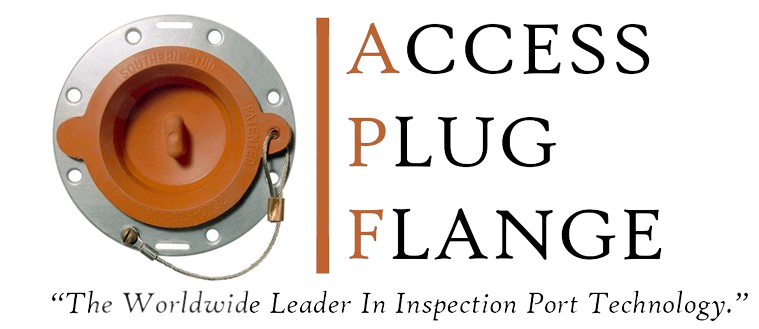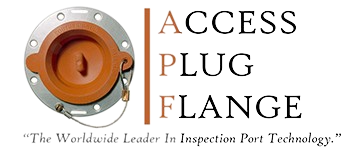APF Advantages
How can it benefit your safety program?
The only inspection port product line that is designed and built to withstand temperatures from -185°F (Cry) to 1,200°F (HT2).
Our inspection port technology incorporates a drawn metal flange that allows for a large silicone volumetric area to provide the best sealing and maximum holding power. The metal flange is what allows us to attach our cryogenic extension tube for cryogenic applications and an optional extension sleeve for insulation separation. These unique flange elements enable APF to have the ONLY cryogenic port and extension sleeve on the market today.
In addition, our flange design provides the largest inspection area and the least insulation loss for the best thermal efficiency on the market.
We have the best Inspection area vs hole size ratio in the industry. As shown by the green graphic in the image to the right, compared to our competition, our inspection port flange is designed with a thinner flange wall. Our thinner flange wall eliminates any 'lip' that is caused by the thickness of our competitors flange wall. In some products, this 'lip' can be as large as 1/4" and that can cause the insulation core to hang upon removal. Our design is the only one available that allows for the use of a solid insulation core if needed.


Due to the flange thickness, you can achieve up to 30% more inspection and insulation area as shown by the green indicator in the cross sectional graphic.
Our optional extension sleeve for material separation saves time and expedites the inspection process by both ending the need to clean the inspection surface of any loose insulation material and also by prohibiting damage to the insulation caused by accidental contact with the inspection probe.
Our flange design produces the largest sealing area and holding power in the industry.
- Adheres to the jacketing surface for safety, as opposed to competitor mostly sealing on the uneven cut of the jacketing edge (see “Inspection Port Cross-Section View” for comparative seal areas in red color)
- Large silicone volume provides elasticity for absorbing jacketing thermal expansion and contraction. It also provides a vapor barrier seal for cryogenic port.
Our inspection port is a Reliable Solution to match your long-term inspection commitment. Our inspection ports help you achieve structural validity that ASTM standards C1729 and C1767 require on jacketing materials for insulation.
No special tools needed — Hole saws or hot work permits are not required for field installations. Work crews at several locations can be installing inspection ports at the same time.
Metal Flange
The metal flange protects against any cutting errors by the installer since the flange is installed over the cut hole. By hiding the cut edge, both the installer and the inspector are protected from the cut edge.
The metal flange make the use of screws to hold the inspection port in place obsolete. Only 2 screws are needed, one is used to attach the safety line to prevent plug loss and a second one is used 180º to secure the flange while the silicone cures.
The metal flange uses the silicone that is applied under the flange as the holding power that secures the inspection port to the jacketing surface. The metal flange is equipped with silicone injection holes to facilitate a better holding power that the competition CANNOT provide with their current design.
Silicone Plug
- By matching the plug to the process temperature, you can protect against port failure due to a loss of the insulation core.
- Designed and engineered to match with a multitude of process temperatures ranging from -112°F to 600°F. (-80°C to 315°C).
- A patented seal breaker tab molded into the center of the plug for one handed use to enhance safety during the inspection process.
- Equipped with a stainless steel safety line that is pre-attached with a copper sleeve to prevent plug loss during the inspection process.
- Equipped with a molded-in stainless steel washer to provide a strain relief to prevent plug loss.
Metal Plug
- Designed for use when process temperatures fall between 600 °F to 1,200 °F.
- Has an interlocking fit with the flange for superior protection against accidental plug removal.
- Incorporates a high temperature »o” ring to provide a weather tight seal that helps protect against heat loss and also provides a vapor barrier
- Can be purchased with a mounted pin that allows you to secure an insulation coupon directly to the back side of the cup to mitigate any insulation core loss.
APF Installation Advantages
APF Inspection Port installation is quick and safe because they attach to the jacketing surface and not to the cut edge. This provides a multitude of benefits as detailed below.
No Hot Work Permit Needed
Since we attach to the jacketing surface and not to the cut edge of the jacketing, a hole saw is NOT required thus eliminating the need to acquire a hot work permit. Since a hot work permit is not required, multiple installers can be working in different areas at the same time. This helps to lessen some of the installation costs by shortening the overall installation time by using multiple installers and also, in the event scaffolding has to be rented and erected, the rental and installation period can be shortened.
Since a hot work permit is NOT required, a shutting down of the process prior to installation is NOT required. Since you are not using a hole saw. Installation of our inspection ports can be performed while the unit is in production since there is no chance of piercing the base metal.
The biggest benefit of not using a hole saw is you lesson the chance of the installer damaging any trace lines that could be under the insulation, or worse, having the installer accidentally drilling through the base metal with the pilot bit of the hole saw.
Protection Against Packeting Expansion/Contracting
When the seal between the inspection port and the jacketing is made by using the interference fit along the cut edge of the hole, the seal can be compromised if the jacketing material expands or contracts after installation. If the inspection port were installed when the temperature was very cold, the cut hole could be become larger once the jacketing expanded because of a temperature increase. ANY expansion of the jacketing could cause the original seal to fail. This failure could allow air or water to breach the seal and penetrate the inspection chamber and get under the insulation. This air/water penetration would allow the conditions to occur that can cause corrosion (CUI). This also applies if the jacketing contracts after installation. ANY contraction could cause a very slight buckle in a soft sided flange. Any type of buckling could also cause the original seal to fail and create the same CUI conditions.
Because of these possible conditions, any installation where the jacketing is cut open should be sealed with a high grade silicone to prevent any type of air or water breach. By sealing to the jacketing surface with the largest sealing area in the industry, we can protect AGAINST any thermal expansion or contraction of the jacketing material after installation.
Strongest Holding Power
Since we have the largest sealing area in the industry and because we perform this sealing under the flange, not only do we create the strongest holding power of any inspection port available on the market due to amount of silicone contact with the jacketing surface, we also lessen the exposure of the silicone to direct UV. These are 2 of the attributes that contribute to our inspection ports being in service longer than any other port on the market after installation.
Inspection Safety & Protection
Our flange COMPLETELY hides the cut edge after installation. When using snips to cut the jacketing, the hole that is created is not perfectly smooth. Our flange is designed with a 'center draw' that drops approximately 1" into the inspection hole to COMPLETELY hide the cut edge for personnel safety. This will protect the safety inspectors during NDT inspections and by hiding the cut edge, your facility can comply with any applicable OSHA standards in regard to safety.

Have a Question?
* Denotes a required fieldSend us a message and our team of experts will get back to you shortly with a prompt response.

